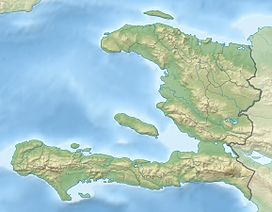Massif du Nord
| Massif du Nord | |
|---|---|
| Highest point | |
| Elevation | 1,219.2[1] m (4,000 ft) |
| Coordinates | 19°35′0″N 72°25′0″W / 19.58333°N 72.41667°W |
| Geography | |
| Location | Haiti |
The Massif du Nord is the longest mountain range of Haiti.[2]
Geography
The mountain range is located in the northern region of Haiti, in the departments of the Nord and in Artibonite. The range's altitude varies from 600–1,210 metres (1,970–3,970 ft). The Plaine du Nord lies along the northern border with the Dominican Republic, between the Massif du Nord and the North Atlantic Ocean. This lowland area of 2,000 square kilometers is about 150 kilometers long and 30 kilometers wide.
It is the western extension of the Cordillera Central that runs through the Dominican Republic.[3][4] This channel extends to the northwest under the name of the Chaîne du Haut-Piton.
A narrow northern coastal plain lies north of the range on the Caribbean Sea. The Guayamouc River flows south from the range.[5]
The Massif du Nord separates the city of Cap-Haïtien from the capital Port-au-Prince.
History
After the Haitian Revolution, the Citadelle Laferrière was built by King Henri Christophe. It overlooks the city of Cap-Haïtien from its height of 865 meters.[6]
See also
References
- ^ Famous Landforms in Haiti
- ^ Matibag, Eugenio (2003). "Haitian-Dominican Counterpoint". p. 19. Retrieved 20 June 2015.
- ^ Britannica: Massif du Nord
- ^ Mann, Paul; Draper, Grenville; Lewis, John F., eds. (1991). "Geologic and Tectonic Development of the North America-Caribbean Plate Boundary in Hispaniola". p. 10. ISBN 0813722624. Retrieved 20 June 2015.
- ^ Country Studies - Haiti: Geography
- ^ Du Boi, Coert (1942). "Caribbean Tourist Trade: A Regional Approach". p. 62. Retrieved 20 June 2015.

